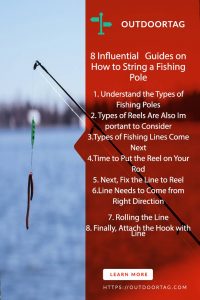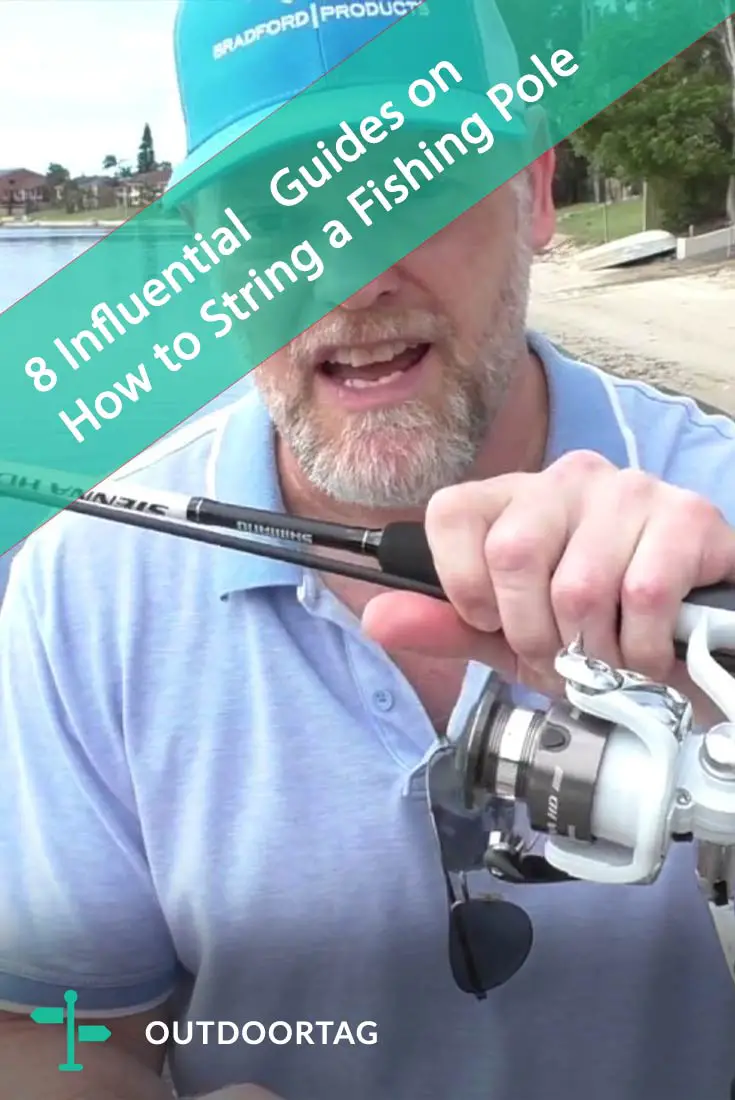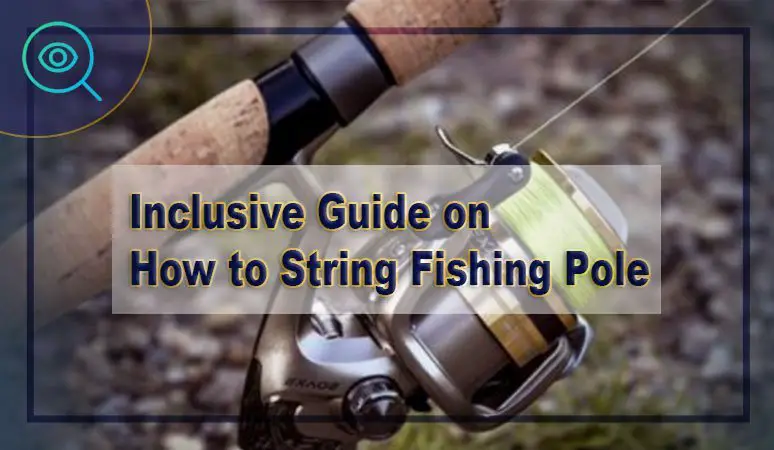if you are someone who possesses the quality of having a great amount of patience, you’ll love fishing . It’s one rewarding activity that some people find boring just because there’s a lot to do with having endurance.
A new fishing enthusiast has a lot to learn and know about . However, one common concept that the newcomers feel a bit perplexed on is about stringing a fishing pole. Without a proper sense of how to string a fishing pole, you can’t expect to catch a lot of fishes. And that’s why it’s high time as a beginner in this fishing territory, you give yourself some time in adapting the skill of proper stringing.
Let’s Learn How to String a Fishing Pole by Starting from Very Beginning!
To a few, how to thread a fishing rod may sound too challenging as a task. And so, it’ll be better for the newbies to start from basics. Stringing a fishing pole needs you to have a good amount of ideas regarding different types of rods, reels, and lines available. Because these parts are also involved in the whole stringing game. Let’s get on it . First we see them in list and then we go for detail

1. Understand the Types of Fishing Poles.
To understand all those so-called fishing pole setup beginners friendly instructions, you also need some basic idea about the rod types that can be involved. Depending on what location, fish species you are aiming for and the task, there will be a need for a specific kind of pole . And that decision will only be right when you have a good sense of the wide range of rods available. Here’re some short notes on that.
The first type is fly rods. These are available in many shapes plus sizes. The flexible rods are pretty good at fly back and forward with fixed-line or bait setup. For small fish species, this type works best. The bigger in size rods are capable of huge species too. There’s no butt piece on flying rods. And so, you get to enjoy a free casting experience with it that lacks the issue of line entangling. The fish line needs to be heavy with this type. In terms of durability, strength, and litheness, these are best to go for.
The next category is about casting rods. For open water or running stream fishing, casting rods work wonderfully. You can position the bait on hook more precisely. And so, the luring is no hassle with this type. Baitcasting and spin casting are two options of this category. The baitcasting rod comes with more than a few tiny eyes including one located near reel. And with a spin-casting rod you get a big eye in the reel area along with other small eyes. The huge eye works in conjunction with reel to get effective results.
The final type is spinning rods that some confuses with casting rod. The spinning rod comes with a less long but lighter body. It comes with a large eye too. The main task for this eye is to minimize any fishing line friction problem. And so, there are fewer chances of snapping or heating with it.
2. Types of Reels Are Also Important to Consider.
Someone who is trying to learn about stringing a fishing rod, there’s a need to understand about reel types that they are going to use. Because depending on the type of reel one is planning to use, there will be some different points to consider. Basically, there are three types of reels you should be aware of.
The first type is spinning reels. These are known for providing better accuracy as well as easier usability. It’s the more popular type as well because of simple functioning and easy to learn design. When you use a spinning reel, go for lightweight lines to get a better result.
Next is the trickier type called baitcasting reel. It comes with a spool that keeps spinning on every cast you make. The reel will be a fantastic type to get accuracy for someone who has a better experience with fishing. Usually, first-timers find this type less suitable for learning.
And finally, the spin-cast reels. This type of reel comes with a closed face. And that’s because its components are all enclosed within a case that is cone-like in shape. A hole is present with it that allows the line to go out. The reel is easier to learn and use. However, there’s less chance of accuracy with it. Also, it’s not the best compared to other types for offering much distance.
3. Types of Fishing Lines Come Next.
What type of fishing line you are using, is also an important factor when learning how to string a pole. Depending on the conditions, rod type, and fishing goals, there will be a need for a certain line.
The first type of line is probably existing for more than thousands of years now. It’s the braided line that comes with woven multiple fibers. When these fibers are inside the water, it becomes less visible as well as thinner. Now, modern technology has bought as many more improved versions of this fishing line type. You get a great amount of strength with the braided lines. Nowadays the unfused braided lines are very popular for its softer manufacturing.
The next type is preferred more by learners since it comes with a fantastic holding ability. It’s the monofilament fishing lines. This type can provide amazing results by not slipping within the knot. The less visible to fish materials are used to create monofilament lines. So that a trap for catching fishes is easy to build. The stretching ability of this line is also excellent. It also comes with memory to stay on rounded or curly shape for a pretty long time.
And finally let’s talk about the relatively new type, fluorocarbon lines. Compared to monoline, this type comes with less memory ability. And so, you get to see straighter shapes with it. The weight and density fall on less slack results. This type works better for baitcasting reels experts and usually, newcomers don’t get it.4.Start the Process by Assembling Your Rod.
Watch This!
4.Time to Put the Reel on Your Rod.
Now you will concentrate on putting the reel over your rod. Just bring the reel out of the package and observe it. Look at the foot part specifically for figuring out which section should connect with a rod. There should be a reel seat on your rod. Have a good look at it as well and understand the locking mechanism.
There can be different sorts of mechanisms used here. It can be cork-and-reel, down-locking, or up-locking type. No matter what locking mechanism you end up with, there’s nothing to worry about. These are pretty easy to get a secure lock from. You need to attach reel in a way that it faces the rod’s tip part.
5. Next, Fix the Line to Reel.
From the spool, you should take loose end of line first. Then simply drag the end through guides or rings of your rod. Make sure to let it go through all of the guides (or rings). You need to begin from the guide that is located right on your rod’s tip part. Then follow its next placed one. Keep on passing in the same manner. And then you should complete the passing with guide located near to reel.
If you are using the most popular spinning reel type that comes with a metallic D shape bail around, then let it stay in an open position. The type that involves close face structure with front cone cover, you need to get rid of cone here first. Use the push button if provided or simply unscrew it. The cone should come with a hole where you need to pass line through.
Now you need to fix the line with spinning part of reel by tying securely. You can use any knot here. Just make sure the knot is good enough to hold things together. Arbor knot is a great option to go for here.
For this, you need to focus on the loose end of line and go for an overhand knot as first tie. Then you need to wrap this line around the reel. Go for making two more overhand slipknots here. You should make all three knots sit securely. Simply pull both ends of the line to make those sit securely on reel’s surface.
6. Line Needs to Come from Right Direction.
Now you need to observe how your reel is turning. The direction needs to be a certain way for it to work better. It can be either clockwise or counterclockwise. Simply put the spool on a surface to check this. If the line seems to come in a counterclockwise manner, then things are fine and you can proceed.
However, if it’s coming clockwise, then there’s some repairing to do. You need to flip the spool over. This will make line come the same as your reel spinning’s direction. It’s important to check the line direction to ignore any twists issue later.
7. Rolling the Line.
Now you need to gradually start turning the reel’s handle. To get enough amount of line, you will require a turning handle somewhere between 20 to 30 times. It’s best to avoid filling the reel to its maximum capacity.
The reel’s lips should have at least 1/8th inch of empty space here. Or else there is a risk of the reel coming off later on. The point that is beyond your rod’s tip, make a cut on your line right here. There should be an extra 2 or 3 feet of line dangling from tip to play it safe. In case of using a front cone reel, you should put it back and ensure it’s not catching with the line.
8. Finally, Attach the Hook with Line.
Beyond the rod tip, you need to attach hook onto line’s open end. Here using a clinch knot will provide best result to tie a hook. You need to let the line go through hook’s eye. Then you need to twist hook, and at the same time keep holding both ends of line.

Go for twisting at least four to five times here. You can also twist them around each other. You need to insert open end of line through the tiny space that is between hook and twist. Finally, pull it through and this will tightly secure a knot. You should leave around 1/8 inch of extra tag while cutting any additional part on the open end.
Some Mistakes You Should Avoid.
There are a few mistakes that people tend to make a lot when stringing a fishing pole. Let’s break down the most common ones below to fulfill your learning session:
1. Wrong Knots Can Bring Miseries.
One of the critical mistakes you can do is tying the wrong knot. You need to use a knot that will be able to withstand the tug created by your catch on a line. Your best bet should be going for two knots or double knotting. This way you may go a bit extra but not anything less to feel later sorry.
2. Line Overfilling.
The line and spool end need to have a specific room in between to work better. Overstepping here can result into a poor performance of reel later on. A spool that is overfilled by string will feel very hard to keep the line tightly against itself. In the worst case, you may experience tangling as well. And that’s huge bad news for your fishing plans for the following day.
3.The Tension Needs to Be Sufficient.
The line having slack is an open invitation to big disasters. Especially if you let your attention slip for a moment. Once the catch pulls on give, your string will tangle since it was too loosely wrapped. And so, it’s very important to tie the line with enough tension to prevent any sort of snapping later on.
4. Don’t Miss an Eyelet.
Since there are micro guides, you may experience coming across a frame that has small gaps right between the actual eyelet and frame. And in this case, usually, the eyelet is very minuscule.
As a result, there’s a chance of running the lines between this hole between frame and eyelet. However, it was supposed to go through the eyelets. This can lead to a very serious problem as sharp edges of frames are extremely dangerous for the lines. So, pay extra attention to gears that come with such confusing combinations.
Also Read: How to Spool a Baitcaster with Different Types of Lines?
Watch This!
Conclusion
For the best catches, you must pay attention to learning how to string a fishing pole. The matter itself comprises other points to understand as well. And hopefully, this guide made your all confusion go away.
Also, you should pay attention to buying a proper reel, rod, and line for this process. The certain types that were mentioned today are available in various models from so many brands. You need to be aware of what a good reel, rod, or line looks like when purchasing any one of these.
Even one poor-quality gear among these will be a problem to deal with no matter how skilled you are with stringing the pole. So, make sure you don’t sleep on that fact and carelessly push it for regretting later.

